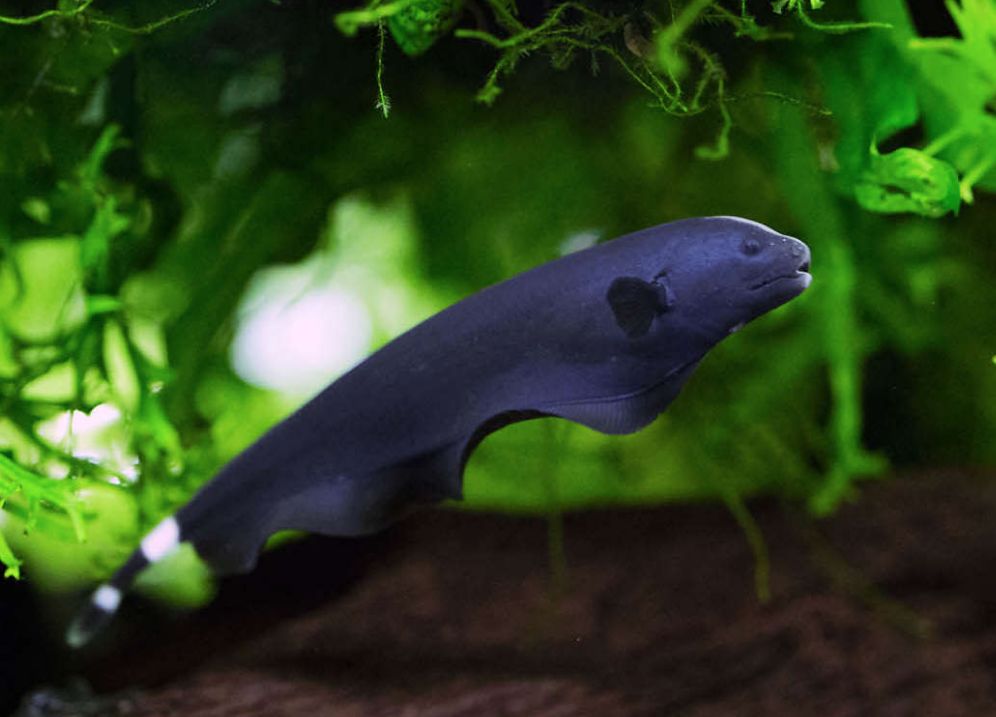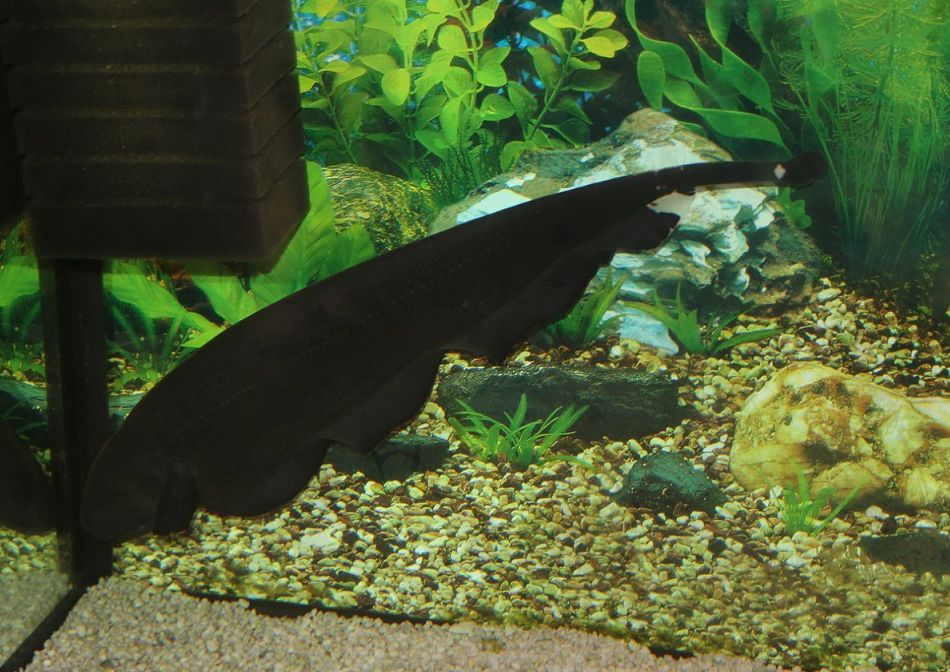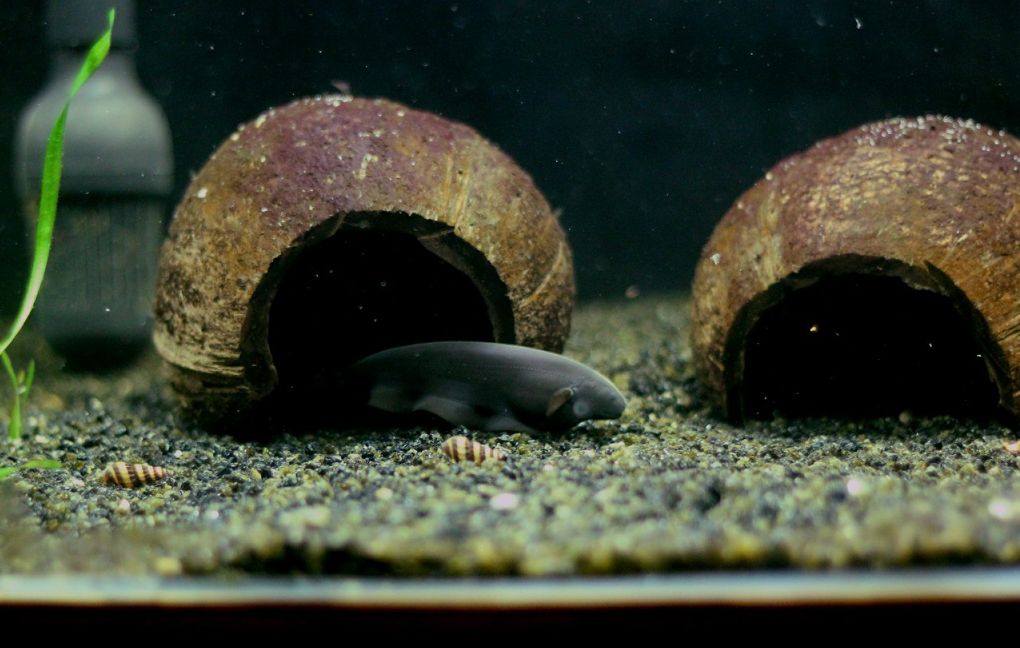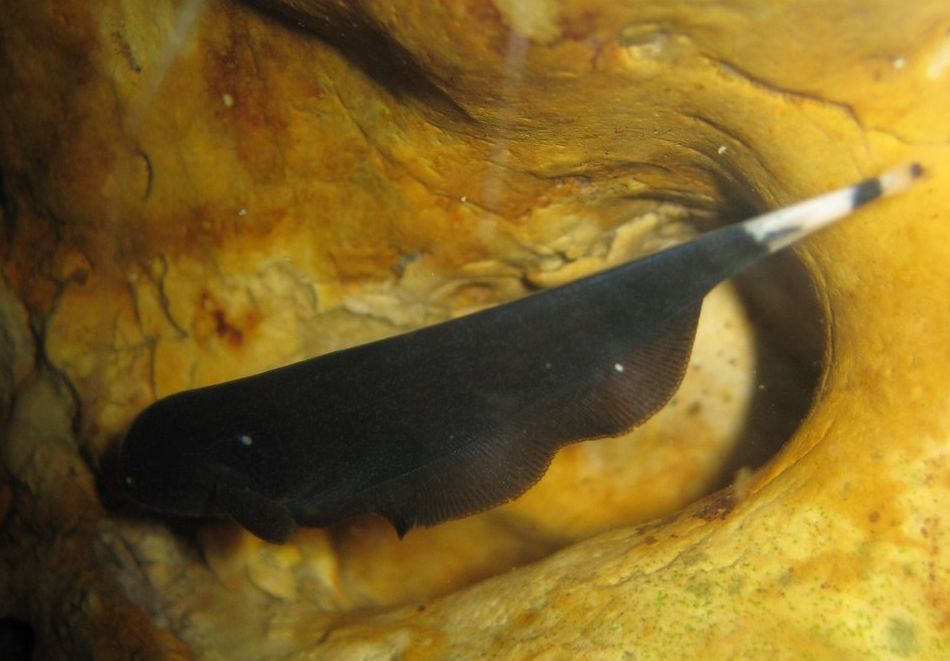Black ghost knife fish (Apteronotus albifrons) is one of the most unusual freshwater fishes that you may encounter in amateur aquariums. The fish has nocturnal habits. During the day time it is rather timid and quite often stays in a shelter on a tank bottom. Black ghost knife fish are popular among aquarium hobbyists due to their unique appearance and behavior. However, they require specific care to thrive in captivity. They need a large aquarium with plenty of hiding places and a sandy substrate. Additionally, they are sensitive to water quality and require regular maintenance and proper filtration.

Contents
Habitat in the wild
In the wild black ghost knife fish originates in upper basin of Amazon river over the territory of Bolivia, Peru, Brazil and Colombia. The fish prefers slow black waters (water with large amount of tanning agents produced by fallen leaves).
In its natural habitat, the black ghost knifefish is typically found in slow-moving or stagnant waters with dense vegetation. They are often encountered in areas with submerged logs, root systems, and aquatic plants. These structures provide shelter and cover for the fish, allowing them to hide and feel secure. The black coloration of their bodies allows them to blend in with the dark, shadowy environments they inhabit. The fish tries to stick to a certain area, which it guards from the species of its kind. Apteronotus feeds on larvae of various insects and juveniles.
The black ghost knifefish has nocturnal habits and it tends to hide in some shelter during a day (under snags or in shore holes). In Amazon river habitat has rather low lighting and the fish has quite poor eyesight due to this. To compensate shortness of vision the black ghost knifefish generates low electric field around itself due to which it senses any movements and defines objects, that allow them to navigate and hunt in dark or murky waters. This electric field helps the fish to hunt and navigate; except this it helps Apteronotus to communicate with the species of its kind and to find females.

Description
Black ghost knife fish body is elongated and has no scales, it gradually narrows towards the tale. Its abdomen is quite flat, the head is large and the mouth is pointed. The black ghost knifefish doesn’t have abdominal and dorsal fins, though its anal fin is rather well developed and it stretches from the head to its tail. Due to waving motion of the anal fin Apteronotus can move in any direction.
The tail fin is relatively small. The body is black with a white line on its back and two yellow-white transverse stripes on its tail stalk. The fish has a dark brown to blackish coloration, with a distinctive white stripe running along the length of its body, hence the name “albifrons” meaning “white forehead” in Latin. The head is flattened with a long snout, and it has a single, ribbon-like anal fin extending along the length of its undersurface.
One of the notable features of Apteronotus albifrons is its ability to produce electric organ discharges (EODs). These discharges are used for navigation, communication, and hunting prey. By emitting weak electrical signals and detecting the distortions caused by nearby objects, the fish can navigate and locate prey even in dark or murky waters.
Size
How big do black ghost knifefish get?
In the wild black ghost knife fish can grow up to 50 cm (20 in) long, in a tank it is up to 40 cm (16 in). However, it’s important to note that individual sizes can vary, and not all black ghost knifefish will reach this maximum size. In aquariums, they are commonly observed to reach sizes between 30 to 45 centimeters (12 to 18 inches). Factors such as genetics, diet, and environmental conditions can influence the growth and size of an individual black ghost knifefish.
Lifespan
How long do ghost knife fish live?
Black ghost knife fish (Apteronotus albifrons), have an average lifespan of around 10 to 15 years in captivity. However, with proper care and favorable conditions, they have been known to live even longer, potentially reaching up to 20 years or more. Providing a suitable environment, appropriate diet, and regular monitoring of their well-being can contribute to their longevity.
| Characteristic | Description |
|---|---|
| Scientific Name | Apteronotus albifrons |
| Common Names | Black ghost knifefish, Brown ghost knifefish |
| Family | Apteronotidae |
| Native Habitat | Freshwater rivers, streams, and flooded areas in South America |
| Distribution | Amazon and Orinoco river basins, Brazil, Venezuela, Colombia |
| Size | Up to approximately 50 centimeters (20 inches) in length |
| Body Shape | Elongated, laterally compressed with a long, thin tail |
| Coloration | Dark brown to black with a distinctive white stripe along body |
| Head | Flattened with a long snout |
| Anal Fin | Single, ribbon-like fin extending along the length of the body |
| Behavior | Nocturnal, primarily active during the night |
| Electric Organ Discharge | Produces weak electrical signals for navigation and prey detection |
| Diet | Carnivorous, feeding on small invertebrates, insects, crustaceans |
| Preferred Habitat | Slow-moving or stagnant waters with dense vegetation |
| Tank Requirements (in captivity) | Large aquarium, plenty of hiding places, sandy substrate |
| Sensory Adaptations | Specialized electric sense for navigation and hunting prey |

Difficulties in keeping
The black ghost knifefish is recommend for experienced aquarists to keep. Since the fish has no scales it is very sensitive to diseases and chemicals in tank water. It is recommend to have an external filter with UV sterilizer, which decreases chances of any diseases development. The fish is also sensitive to tank water parameters and their abrupt change.
Like many similar fishes Apteronotus is timid and hesitant, especially when put in a new tank. Another problem is that it is a nocturnal predator and it should be fed at night or in the evening.
Keeping in a tank
Tank size
An adult black ghost knife fish is a large fish and it needs a large tank. It is generally recommended to provide a tank with a minimum size of 75 gallons (284 liters) for a single black ghost knife fish. However, providing a larger tank is even better, as it allows for more swimming space and provides a more comfortable environment for the fish.
The elongated body shape and active nature of black ghost knifefish necessitate horizontal swimming space rather than vertical height. Therefore, it’s advisable to select a tank with dimensions that are long and wide, such as a tank that is at least 4 feet (120 cm) in length.
Additionally, black ghost knifefish prefer calm waters, so it’s essential to ensure that water flow in the tank is minimal. If you plan to keep multiple black ghost knifefish in the same tank, you will need to provide additional space to accommodate their territorial behavior. Each fish should have sufficient room to establish its territory and avoid conflicts.
Water parameters
The optimal temperature range for black ghost knifefish is around 25-28°C (77-82°F). Black ghost knifefish prefer slightly acidic to neutral water conditions. The recommended pH range is typically between 6.5 and 7.5. They generally tolerate a moderate level of water hardness. Aim for a range of 5-12 dKH (carbonate hardness) or 2-15°dH (general hardness).
Filtration
A powerful external filter is a must for such a tank. A combination of mechanical, chemical, and biological filtration is recommended. Regular water changes, typically around 20-30% every two weeks, can help maintain water quality and dilute any accumulated toxins.
The fish produces lots of waste, since it eats protein food and it is sensitive to tank water quality. Using such a filter will help you to solve lots of problems if the fish gets ill. Infectious diseases are much more dangerous for this fish, then for any other tank dweller because it has no scales on its body.
Ammonia and nitrite levels should be maintained at zero. Regular testing and proper filtration are essential to ensure a healthy environment. The presence of ammonia and nitrite can be harmful or even fatal to the fish.
Tank decor
The black ghost knife fish is a nocturnal predator. Most of the time it spends close to the tank bottom. During the day it likes hiding in shelters and leaves them only to feed or at night.
It is better to keep black ghost knife fish alone in a tank, since adult males quite often fight to guard their territory. If you have more than one species in your tank, it is desirable to provide them with large number of shelters (snags, stones, caves etc.) Some aquarists use transparent tubes where the fish feels safe, but at the same time you can see it.
It is desirable to have some floating plants in a tank to create half-light and to create average water flow there.
Diet
Is a carnivorous one and in the wild it mainly feeds on small invertebrates, insects, crustaceans, and occasionally small fish.
In a home tank nothing changes greatly – the black ghost knife fish eagerly eats both live and frozen food: bloodworms, brine shrimp, daphnia, blackworms, or small insect larvae. Black ghost knifefish can also be fed small pieces of meaty foods such as shrimp, small fish fillets, or finely chopped seafood.
You can supplement their diet with high-quality pellets or flakes specifically formulated for carnivorous fish. Look for products that contain high levels of protein and are suitable for bottom-dwelling or nocturnal species.
It is recommend to feed once a day before switching on the tank lighting or after the lights are off. When looking for food the fish relies on how electromagnetic fields change. It detects these changes by means of special receptors located along the whole length of the body.

Tank mates
Black ghost knifefish are generally peaceful and prefer calm tank mates. Avoid aggressive or fin-nipping species that may harass or stress the knifefish. Compatibility with other fish largely depends on individual temperaments, so closely monitor their interactions when introducing new tank mates. The black ghost knife fish is compatible with any non-aggressive species except small fishes like neon tetra or guppy, which it will treat as food.
Here are some examples of suitable tank mates:
- Large peaceful cichlids: Species like angelfish (Pterophyllum spp.) and some peaceful South American cichlids such as Severums (Heros spp.) or Geophagus species can work well in larger tanks. Ensure that the cichlids are not overly aggressive and can tolerate the knifefish’s presence.
- Larger peaceful catfish: Certain larger catfish species can be compatible, such as larger Plecos (e.g., Bristlenose Plecos – Ancistrus spp.) or larger Corydoras catfish. Choose species that are not aggressive or predatory towards the knifefish.
- Gouramis: Peaceful gourami species like Pearl Gouramis (Trichogaster leeri) can be suitable tankmates, provided they are not overly aggressive or territorial.
Gender differences: male vs female
The black ghost knife fish doesn’t have rather strong gender dimorphism. Unlike some fish species, they do not display significant sexual dimorphism in terms of coloration, fin shape, or body size. In the wild male and female find each other due to electrical pulses they irradiate, which are of different frequency for the male and female.
Breeding
For black ghost knife fish breeding you’ll need a thickly planted tank with snags and shelters. The fish should have a balanced diet that includes live food (bloodworm, worms) – all these contributes to the fish getting reproductive.
As a rule the breeding stock appears within the group of 6-10 species. You can stimulate breeding by flooding and draining the tank, i.e. simulating rain and drought periods in the wild.
The clutch is usually between some snags or in a cave. Yellow eggs are 2 mm in diameter. Three days later the larvae appears.